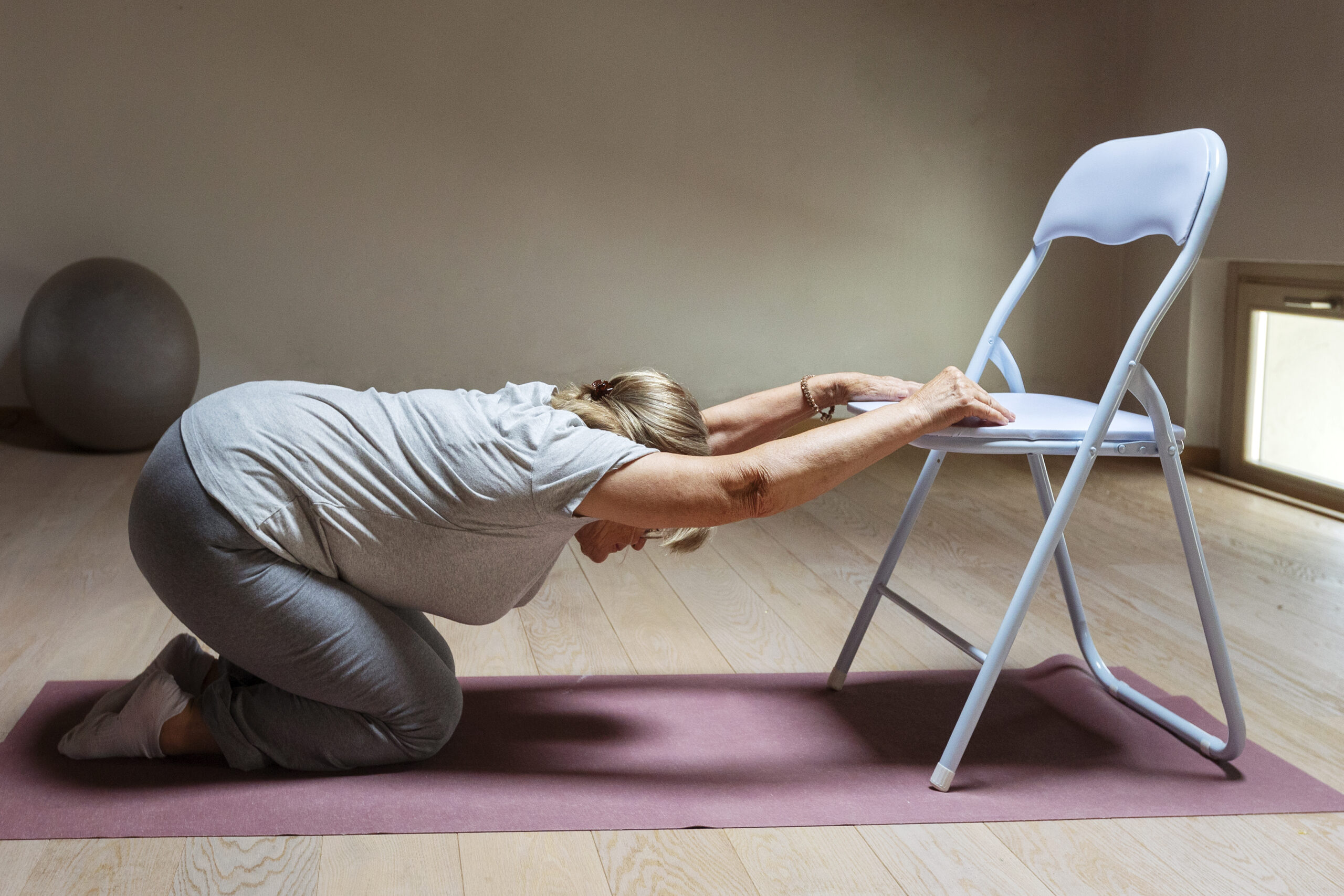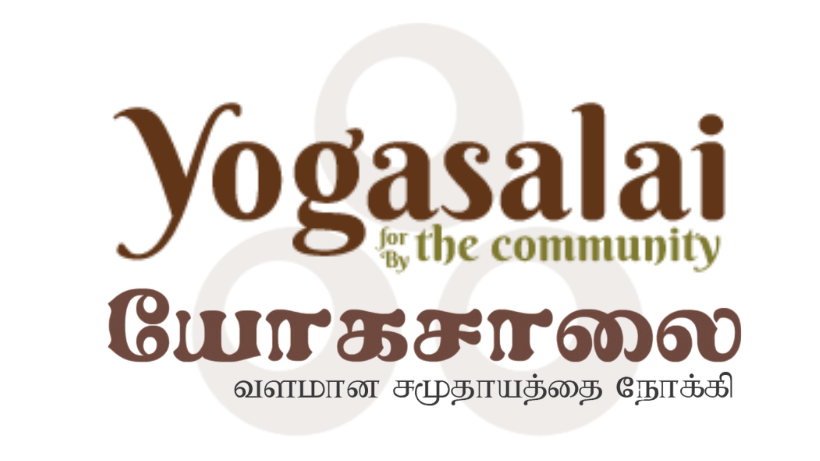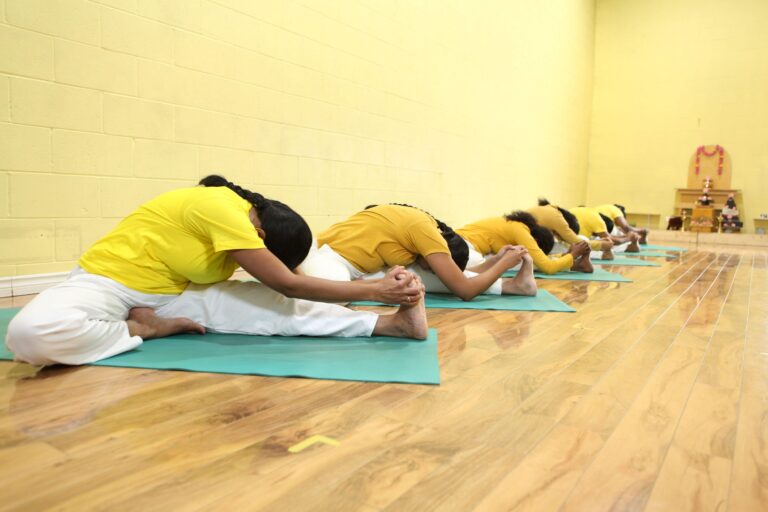
கதிரையில் யோகம் (Chair Yoga)

யோகத்தில் இயற்கையோடு ஒத்து எம்மை இயற்கையின் ஓர் அங்கமாக உணர்ந்து,
எமக்கும் எம்மைச் சுற்றியுள்ளவற்றிற்குமான தொடர்புகளையும் தாக்கத்தையும் aஉணர்ந்து,
இயற்கையால் எமக்கு அளிக்கப்பட்ட சமநிலையைப் பேணி உடல் நலத்தையும்,
மனநலத்துடன் எமது சக்தி உடலின் நலத்தையும் பேணி மகிழ்ச்சியுடன் வாழ்வதையே
யோக வாழ்க்கை என்கின்றோம்.
யோக வாழ்க்கையின் அடிப்படை
இவ்வாறான ஒரு வாழ்க்கை ஒழுங்கான உடல் பயிற்சியுடன்,
மூச்சுப்பயிற்சியையும் உடல் மற்றும் மனதை ஒழுங்கான ஓய்வு நிலைக்கு கொண்டுசெல்லக்கூடிய
பயிற்சிகளையும் செய்து நற்சிந்தனையுடன் தியானப்பயிற்சியையும் செய்வதையே அடிப்படையாகக் கொண்டது.
இவையுடன் ஒழுங்கான உணவு உட்கொள்ளும் ஒழுக்கத்தையும் பெற்று வாழ்வதன் மூலம்
யோகக் கலையின் பலனை அதிகரிக்கலாம்.
இக் கலையைச் செய்வதற்கு உடம்பு வளையும் தன்மையுடன் இருந்தால் மட்டுமே செய்ய முடியும் என்று
பலரும் எண்ணிக்கொண்டு இருக்கின்றோம். ஆனால் உண்மையில்,
இப்பயிற்சியைச் செய்வதனால் வரும் ஒரு பக்க விளைவே உடம்பில் ஏற்படும் நெகிழ்வுத்தன்மை ஆகும்.
உடம்பில் பிராண சக்தி அதிகரித்து தடையின்றி சீராகப் பாயும் பொழுது,
உடம்பின் அசைவுகளும் நெகிழும் தன்மையும் அதிகரிக்கும். அதுடன் மனதும் சுறுசுறுப்புடன், கூர்மையாகச் செயல்படும்.
கதிரையில் இருந்து செய்யும் யோகம்
கதிரையில் இருந்துகொண்டு பல பயிற்சிகளைச் செய்து எம்மால் பல பயன்களைப் பெற முடியும்.
கதிரையில் இருந்து செய்யும் பயிற்சிக்கு கவனம் செலுத்துதல் முக்கியம்.
உள் உணர்வுகளை கூர்ந்து கவனித்துச் செய்வதன் மூலம்
எம்மை நாம் உணர்ந்து பயிற்சியின் பலனை அறிந்து அத்தன்மையைப் பெற முடிகிறது.
கதிரையில் இருக்கும் முறை
- முதுகை நேராக வைத்திருத்தல் அவசியம்
- தோள்களை ஓய்வாகவும் நேராகவும் வைத்திருக்க வேண்டும்
- கால்களை நிலத்தில் பதித்து வைக்க வேண்டும்
- உள்ளங்கைகளை தொடைகளுக்கு மேல் வைத்திருத்தல் வேண்டும்
- உறுதியான, ஒழுங்கான, மெத்தை இல்லாத கதிரையில் இருந்து செய்தல் வேண்டும்
கதிரையில் யோகம் செய்யும்போது கடைபிடிக்க வேண்டிய விதிகள்
- வெறும் வயிற்றில் பயிற்சி செய்தல் வேண்டும்
- மலம், சலத்தை அடக்கிக்கொண்டு பயிற்சி செய்தல் கூடாது
- காற்றோட்டமான அறையில் இருந்து செய்தல் அவசியம்
- பயிற்சிக்கு நடுவில் நீர் அருந்தக் கூடாது
- கால்ப்பாதத்திற்கு அடியில் மிதியடி இருத்தல் நன்று
- வசதியான பருத்தி உடைகளை அணிந்து செய்தல் நல்லது
- உடைகள் இறுக்கமாகவோ பயிற்சிக்குத் தடையாகவோ இல்லாமல் தளர்வாக அணிதல் வேண்டும்
முதுகுத்தண்டை மையப்படுத்திய பயிற்சிகள்
அவ்வாறு செய்வதன் மூலம் பலனையும் அடையலாம்.
உடம்பின் மையமான முதுகுத்தண்டை மையப்படுத்தி எமது பயிற்சியைக் கட்டமைக்கலாம்.
முதுகை இயல்பாக:
- முன்னால் வளைக்கலாம்
- பின்னால் வளைக்கலாம்
- பக்கவாட்டில் இருபக்கமும் வளைக்கலாம்
- இருபக்கமும் திருப்பலாம்
- அத்துடன் மேல்நோக்கி சிறிது நீட்டிக்கலாம்
பயனுள்ள ஆசனங்கள்:
- பச்சிமோத்தாசனம் – இருந்து முன்னால் வளைதல்
- புஜங்காசனம் – பாம்பாசனம்
- திரிகோணாசனம் – முக்கோண ஆசனம்
- அர்த்த மச்சேந்திராசனம் – உடம்பை முறுக்கித் திருப்பும் ஆசனம்
இவைகளின் நோக்கம்:
முதுகை நெகிழும் தன்மையுடன் வைத்து, சக்தியின் ஓட்டத்தை அதிகரித்து சீர்படுத்துதல்;
உள்ளுறுப்புக்களின் செயல்பாட்டை துரிதப்படுத்துதல்.
ஆசனத்தின் அர்த்தம்
ஆசனம் என்பது ஒரு நிலையில் பெரும் சிரமம் இன்றி,
சுகமாக அந்நிலையில் குறிப்பிட்ட அளவு நேரம் நிலை நிற்பதே ஆகும்.
உதாரணம்: கதிரையில் இருந்து செய்யும் முன்னால் வளைதல்
கால் பாதத்தை நிலத்தில் வைத்து,
மூச்சை வெளியே விட்டவாறு முன்னால் வளைந்து,
தொடைகளுக்கு மேல் நெஞ்சை வைத்து,
நாடியை நெஞ்சோடு ஒட்டி,
கைகளை நிலத்தில் வைத்து 30–45 விநாடிகள் பிடித்திருக்கலாம்.
இவ்வாறு செய்வதனால் முன்னால் வளைவு ஆசனத்தின் பெரும் பலன்களை அடையலாம்.
அர்த்த மச்சேந்திராசனம் (முறுக்காசனம்)
கதிரையில் இருந்து சாய்ந்து இருக்காமல்,
நேராக நிமிர்ந்திருந்து மூச்சை வெளிவிட்டவாறு வலது பக்கமாக திரும்பி,
தலையை பின்னால் பார்க்க முயற்சிக்கலாம்.
- வலது கையை உடம்பின் பின்னால் வைக்கவும்
- இடது கையால் வலது தொடையைப் பிடிக்கவும்
- அல்லது கதிரையின் வலது விளிம்பைப் பிடித்து உடம்பைத் திருப்பவும்
- 30 விநாடிகள் நிலைத்து இருக்கவும்
- பின்னர் இடது பக்கமாகவும் இதேபடி செய்யவும்
பலன்கள்:
முதுகுத்தண்டு நெகிழ்வு, வலிமை அதிகரிப்பு, சக்தி ஓட்டம் சீராக்கம்,
கழிவுகள் நீக்கம், வாத பித்த சமநிலை.
நின்று செய்யக்கூடிய ஆசனங்கள்
இவைகள் கால்களுக்கு வலிமை அளித்து,
இடுப்புப் பகுதிக்கு ஆதாரம் தருகின்றன.
- எளிமைப் படுத்தப்பட்ட பாதஹஸ்தாசனம் – நின்று முன்னால் வளைதல்
- எளிமைப் படுத்தப்பட்ட திரிகோணாசனம் – முக்கோண வடிவ ஆசனம்
- உக்காராசனம் – முழங்கால்களை மடித்து நிற்றல்
- இயலுமானவர்கள் வீராசனம் பயிற்சியையும் செய்யலாம்
ஒவ்வொரு ஆசனத்திற்கும் அதன் சமநிலைப் பயிற்சியை அதே கால அளவில் செய்வது அவசியம்.
மூட்டுப் பயிற்சிகள்
மூட்டுகளை நெகிழ வைக்கவும்,
சக்தியின் செயல்பாட்டை அதிகரிக்கவும்,
மூட்டுப் பகுதியில் உள்ள தசைகளை வலிமைப்படுத்தவும் இப்பயிற்சிகள் உதவும்.
கண்களுக்கு பயிற்சிகள்
- உடல், மனம் ஓய்வான நிலையில் இருக்க வேண்டும்
- மூச்சு சீராக இருக்க வேண்டும்
- கண்களை கூரையை நோக்கி, பின்னர் நிலத்தை நோக்கி பார்க்கவும் – 6 தடவைகள்
- தலையைக் குறுக்காமல் கண்களை வலது–இடது பக்கம் பார்க்கவும் – 6 தடவைகள்
- கடிகார திசை, எதிர் திசை – கண்களைச் சுழற்றவும் – 6 தடவைகள்
பின்னர் உள்ளங்கைகளை உரசி கண்களில் வைக்கவும்.
உரசும் பொழுது வரும் சூடு கண்களுக்கு வலு சேர்க்கும்.
கழுத்திற்கான பயிற்சி
- உடல் நேராக இருக்க, தலையை மட்டும் அசைக்கவும்
- மூச்சை வெளியே விட்டவாறு தலையை வலது பக்கம் முழுமையாக திருப்பவும்
- மூச்சை உள்ளே எடுத்தவாறு நேராக வரவும்
- இதேபோல் இடது பக்கமும் செய்யவும் – 3 தடவைகள்
சுழற்றி செய்யும் முறை:
மூச்சை வெளியே விட்டவாறு தலையை முன்னால் சாய்த்து,
மூச்சை உள்ளே எடுத்தவாறு பின்னால் சாய்த்து,
பக்கவாட்டிலும் இதேபடி செய்யவும் – 6 தடவைகள்.
தோள்களுக்கான பயிற்சி
- இயல்பான மூச்சுடன் தோள்களை முன்னோக்கி சுழற்றவும் – 6 முறை
- அதேபோல் பின்னோக்கியும் செய்யவும் – 6 முறை
- மூச்சை உள்ளே எடுத்தவாறு தோள்களை மேலே தூக்கி,
வெளியே விட்டவாறு இறக்கவும் – 6 முறை
சமன முத்திரை பயிற்சி:
விரல் நுனிகளை ஒன்றாக இணைத்து, முழங்கைகளை நேராக வைத்து,
கைகளை முன்புறமாகவும் பின்னோக்கியும் சுழற்றவும் – தலா 6 முறை.
மூச்சை உள்ளே எடுத்தவாறு கைகளை மேலே தூக்கி,
வெளிவிட்டவாறு கீழே கொண்டுவரவும்.
கைகளை விரித்து பக்கவாட்டிலும் மேலே தூக்கி மெதுவாக இறக்கவும் – 6 முறை.
கைகளுக்கான பயிற்சி
- விரல்களை வேகமாக நீட்டி மடித்தல்
- கணுக்கைகளை முன், பின் நோக்கி சுழற்றல்
- மூச்சை உள்ளே எடுத்தவாறு கைகளை பக்கவாட்டில் மேலே தூக்கி,
உள்ளங்கைகளை ஒன்றாகச் சேர்த்து, மூச்சை வெளியே விட்டவாறு கீழே கொண்டுவரல்
மூச்சுப்பயிற்சிகள் மற்றும் ஓய்வு
இப் பயிற்சிகளுடன், யோகக்கலை ஆசிரியரிடம் சில மூச்சுப்பயிற்சிகளையும்,
எளிய முத்திரைப்பயிற்சிகளையும் கற்றுச் செய்வது நல்லது.
இவற்றுடன் ஒழுங்கான ஓய்வெடுக்கும் பயிற்சியையும் மேற்கொள்ளல் அவசியம்.
Chair Yoga
In yoga, we attune ourselves with nature — recognizing that we are a part of it.
By realizing the connection and interaction between ourselves and everything around us, we strive to maintain the balance nature has gifted us.
Through this balance, we preserve physical health, mental well-being, and the vitality of our energy body, leading to a joyful and harmonious life.
This is what we call a yogic way of life.
The Foundation of a Yogic Life
Such a life is built on:
- Regular physical exercise,
- Breath regulation,
- Practices that bring both body and mind to a state of relaxation, and
- Meditation performed with noble and focused thoughts.
In addition, following a disciplined and balanced diet enhances the full benefits of yogic practice.
Many believe that one must already be flexible to practice yoga.
In truth, flexibility is not a requirement — it is a result of regular practice.
When prāṇa shakti (life energy) increases and flows smoothly throughout the body, the movements become more fluid and the body more supple.
Along with this, the mind becomes alert, clear, and vibrant.
Practicing Yoga on a Chair
Numerous yoga practices can be done while seated on a chair and can offer many benefits.
The most important factor in chair-based yoga is awareness and focus.
By turning attention inward and being fully aware during practice, we can experience its full benefits and develop deeper self-understanding.
Correct Sitting Posture
- Keep the spine upright and straight.
- Shoulders should remain relaxed and even.
- Feet should be flat on the ground.
- Place the palms on the thighs.
- Sit on a firm, stable chair without cushions.
Guidelines for Chair Yoga Practice
- Practice on an empty stomach.
- Do not suppress natural urges during practice.
- Practice in a well-ventilated space.
- Avoid drinking water during the practice session.
- A small footrest or support under the feet is helpful.
- Wear comfortable cotton clothing.
- Clothes should be loose and non-restrictive.
Spinal-Centered Practices
Yoga practice can be structured around the spinal column, which is the central axis of the body.
The spine can naturally move in six directions:
- Forward bending
- Backward bending
- Side bending to both sides
- Twisting to both sides
- Gentle upward extension
Beneficial Postures
- Paścimottānāsana – Seated Forward Bend
- Bhujangāsana – Cobra Pose
- Trikoṇāsana – Triangle Pose
- Ardha Matsyendrāsana – Half Spinal Twist
Purpose:
To maintain flexibility of the spine, enhance the flow of energy, and stimulate the functioning of internal organs.
Meaning of Āsana
An āsana is a posture in which one can remain steady and comfortable for a certain period of time, without strain.
Example: Forward Bend from the Chair
- Sit with the feet flat on the floor.
- Exhale and bend forward from the hips.
- Rest the chest over the thighs.
- Bring the abdomen close to the thighs.
- Place the hands on the floor and hold for 30–45 seconds.
This provides most of the benefits of a traditional seated forward bend.
Ardha Matsyendrāsana (Seated Spinal Twist on Chair)
- Sit upright without leaning on the backrest.
- Exhale and twist the body to the right, turning the head to look over the right shoulder.
- Place the right hand behind the body.
- Use the left hand to hold the right thigh or the right edge of the chair for support.
- Hold the posture for 30 seconds.
- Repeat on the left side.
Benefits:
Improves spinal flexibility and strength, regulates the flow of energy, removes toxins, and balances vāta and pitta doshas.
Standing Postures
These poses strengthen the legs and provide stability to the hips.
- Simplified Pāda-Hastāsana – Standing Forward Bend
- Simplified Trikoṇāsana – Triangle Pose
- Utkatāsana – Chair Pose (Squat-like posture)
- Those who are able may also practice Vīrāsana – Hero Pose.
Each posture should be balanced with its counterpose for the same duration.
Joint Exercises
These exercises help to:
- Improve joint mobility,
- Enhance energy circulation, and
- Strengthen the muscles around the joints.
Eye Exercises
- The body and mind should be relaxed, and breathing even.
- Look up at the ceiling, then down at the floor – 6 times.
- Without moving the head, look right to left – 6 times.
- Rotate the eyes clockwise and counterclockwise – 6 times.
- Rub the palms together to generate warmth and place them gently over the eyes.
The warmth energizes and relaxes the eyes.
Neck Exercises
- Keep the body still and move only the head.
- Exhale as you turn the head fully to the right.
- Inhale as you return to center.
- Repeat on the left – 3 times.
- For circular movement:
- Exhale while lowering the chin forward,
- Inhale while lifting the head back,
- Continue side to side — 6 times.
- Exhale while lowering the chin forward,
Shoulder Exercises
- Rotate the shoulders forward – 6 times (normal breathing).
- Rotate backward – 6 times.
- Inhale while lifting the shoulders up; exhale while releasing down – 6 times.
Saman Mudrā Exercise:
- Join the fingertips together, straighten the elbows, and rotate the arms forward and backward – 6 times each.
- Inhale as you lift the arms upward; exhale as you lower them.
- Stretch the arms sideways and upward, then slowly lower – 6 times.
Hand Exercises
- Rapidly open and close the fingers.
- Rotate the wrists forward and backward.
- Inhale, lift the arms sideways and bring the palms together overhead.
- Exhale, lower them down gently.
Breathing and Relaxation
Along with these exercises, it is recommended to learn basic breathing practices (prāṇāyāma) and simple mudras from a qualified yoga teacher.
Regular relaxation practices are equally essential to integrate the benefits of yoga into daily life.


